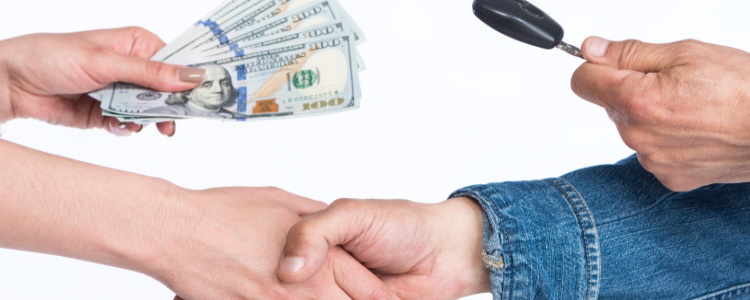Trade-ins are a hot commodity right now, thanks to a shortage of new vehicles. With fewer new cars on dealer lots, comes more demand for used vehicles. Even though your trade-in may be welcomed with open arms, there are a few things you should know to prepare for the trade-in process.

What Should I Know Before Trading In My Car?
Knowing How a Trade-In Goes
Trading in your vehicle can be as simple as finding a dealership, telling a dealer you have a trade-in, and wait for them to give you an offer. If you accept the offer, you sign the title over to the dealership and collect the money.
When you’re trading in your car and want to put the money toward another vehicle, the dealership typically handles most of that for you. The amount you’re getting from the trade-in is listed on your buyer’s order for the next vehicle and is subtracted from the selling price of the car you're purchasing.
There isn’t much you need to bring to a dealership besides yourself, your driver’s license, the vehicle, and the title (if you have it). Trading in your car can be a much more streamlined process than selling it yourself, which is appealing to many consumers.
According to Edmunds, if you’re just trading in a car, you may only be at the dealership for around 30 minutes to an hour, if you have all your paperwork ready. If you’re trading in and buying a car on the same day, it may take a few hours, possibly four to five hours or longer, to complete both transactions.
Tips on Preparing for a Trade-In
 Trade-ins are very common, and an experienced dealership should be able to walk you through the process with ease. That being said, there are a few things to know before you get started:
Trade-ins are very common, and an experienced dealership should be able to walk you through the process with ease. That being said, there are a few things to know before you get started:
- If you own your car outright, be sure to bring the vehicle’s title with you. Without the title, the transaction can’t be completed.
- If you still have a loan on your trade-in, your lender may have the title. Most states are title-holding, which means the lender keeps the title until the car is paid for. In this case, they send it to the dealer for you. If you live in a non-title holding state, you should have the title even if you have a loan, and need to bring it to the dealership.
- If you still have a loan on the vehicle, look up your loan balance to see if your vehicle has equity. Before you can sell a car with a loan, you have to pay your remaining loan balance. If your trade-in offer covers it, you won't have to pay anything additional out-of-pocket. Any extra money left after that can be put toward your next vehicle.
- Trade-in offers are typically good for around one week. Don’t feel rushed to accept the first offer you get. Most dealerships accept trade-ins in good condition, and it’s in your best interest to get a few offers from a few dealers.
- Inform your auto insurance that you’ve sold the vehicle, and if you’re looking to transfer the coverage to another car, let them know and get that sorted.
- The dealer is the one that determines your vehicle’s actual cash value. The offer you get from a dealership can vary depending on their current stock, your car’s actual condition, the season, and your geographic location. A value you may see online can vary greatly from what a dealer is willing to pay you for your vehicle.
ACE Tip: Consider clearing out most of your personal belongings before you head out to the dealership. Check under the seats, glove box, trunk, take the change out of the cup holders – anything you don’t grab before you complete the sale is likely to be tossed once you leave.
Know-How to Negotiate a Trade-In
Dealerships typically take trade-ins with the intent of selling it later as a used vehicle. If you’re out to get the most out of your trade-in, haggling with a dealer may get you the deal you're looking for.
However, this can be stressful for many consumers. You can give yourself an edge in negotiations by following a few simple tips:
- Look up your trade-in’s value. Knowing your vehicle’s estimated trade-in value can give you a lot of power in negotiation. You can even start the conversation with a few estimated values, and walk away from the sale knowing that you didn’t get the wool pulled over your eyes.
- If you have service records, bring them. This can include recent oil changes and repairs you had done on the vehicle. Documents that prove you took care of your car can give you an edge in negotiation.
- Consider a detailed cleaning. Vacuuming the cabin, wiping down the infotainment system, cleaning stains on seats, going through a car wash, shaking out floor mats, and sanitizing the dash and console. A little elbow grease can go a long way and make a good impression.
- Skip the major repairs. If there’s a repair that needs to be done on your trade-in and it’s likely to cost you a few hundred dollars or more, then it may be a better idea to skip that repair. Dealerships can often do repairs for much cheaper than you can, and in the end, the cost of fixing a major malfunction could mean not making much on the deal.
- Buying? Negotiate the trade-in after. A good tactic you can use if you’re buying a vehicle is to negotiate your trade-in’s offer after you’ve settled on the selling price of your next car. A dealer may be less likely to haggle on your next vehicle if they know they’re already paying you for your trade-in. Mention your trade-in after you get a buyer’s order for your next car drafted.
If you’re not much of a haggler, then an easy way to negotiate is knowing what your vehicle’s estimated value is, and how much you want to get out of it, then settling on a price. Remember, you don’t have to accept an offer right away, and should get multiple offers to ensure you're getting the most out of your trade-in.
Some dealerships also offer over-the-phone estimates, too, which can be a good place to start. We recommend contacting around three dealerships for estimated trade-in values – make sure at least one of them is a franchised dealer with your vehicle manufacturer since they may be willing to give you a little more.
ACE Tip: If you think that not telling the dealer about a problem with your car is going to get you a higher offer, it may not work out that way. Dealerships often go through inspections or even test drive your vehicle before giving you an offer. At the very least, they’re likely to start it up and listen to the car for major issues.
The Bottom Line
The important things to take away are to bring your vehicle’s title if you have it, having a valid driver’s license or identification, and being prepared to spend some time at the dealership if you’re trading in.
Trade-ins are also very useful for borrowers with less than perfect credit, since trade-in equity can be used to meet the down payment requirement of a bad credit auto lender. And if you need bad credit lending resources, then look no further than us at Auto Credit Express.
We’ve created a nationwide network of dealerships that are signed up with subprime lenders. These lenders assist borrowers with bad credit vehicle financing, and we want to help you locate a dealer that works with these lenders. Complete our free auto loan request form and we’ll look for a special finance dealership near you.

Senior Auto Financing Editor
Suggested Posts For You
Receive Free Updates
Get the latest credit tips, resources and advice delivered straight to your inbox.













